Dumpster Rental Prices in St. Louis
The average cost of a roll off dumpster rental in St. Louis ranges from $414 to $915. Prices are influenced by your address, the size of the dumpster you choose and what you’re throwing away. Watch out for overage charges, which can occur if your load is too heavy or your rental lasts longer than expected.
Dumpster Size | Price Range |
|---|---|
10 Yard | $414-$629 |
15 Yard | $462-$578 |
20 Yard | $479-$705 |
30 Yard | $613-$810 |
40 Yard | $710-$915 |
Psst. Prices are based on various factors, including debris type. We may have more options if you call! (Last updated: 12/19/2025)
Available St. Louis Dumpster Sizes
From small cleanouts to major remodels, our St. Louis dumpster rentals are built to handle the job. Whether you’re updating a brick home in The Hill or clearing out a loft in Downtown West, we make disposing of debris simple. With prices ranging from $414 to $915, it’s easy to keep your project moving with a roll off dumpster close by.

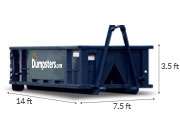
Best for
- Roofing projects
- Single room cleanouts
- Concrete, asphalt & brick
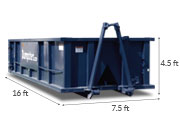
Best for
- Home cleanouts
- Small home remodels
- Landscaping projects
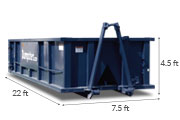
Best for
- Home cleanouts
- Midsize home remodels
- Deck removal
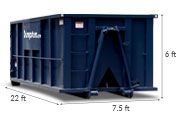
Best for
- Midsized remodels
- Whole-home cleanouts
- Construction projects
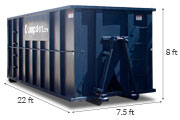
Best for
- Large construction
- Demolition projects
- House cleanouts
FAQs
What's included in the cost when I rent a dumpster?
Roll off dumpster costs typically include drop-off, pickup, a specified weight limit, the rental timeframe and local disposal fees. The exact amount you pay can vary based on your location, the dumpster size and the type of waste you’re removing.
Do I need a permit for my dumpster rental?
If you opt for driveway placement, no permit is needed. However, if you need the bin in a street or public right-of-way, you'll need to reach out to the St. Louis Street Department at least one week before the delivery date to request a Blocking Right of Way Permit.
What can I expect after I order?
On your scheduled delivery day, your dumpster could be dropped off at any time. You won’t need to be present, but please keep the area open and free of cars, gates or other barriers. If you need to change the delivery date, get a second dumpster or arrange for pickup, use our Service Dashboard.
What can't I throw away in a roll off dumpster?
Our St. Louis roll off dumpsters can handle most materials, but certain items are always off-limits. Hazardous, toxic or flammable waste is prohibited for safety and environmental reasons. Contact our team if you’re unsure about what you can toss.
How much does a dumpster rental cost in St. Louis?
Most dumpster rentals fall in the $414 to $915 range. The total will be influenced by your address, the size of your bin and the debris type. For exact pricing, check online or contact us directly.
How to Order a Dumpster
- Call or check pricing online
- Give us your address
- Choose your project and debris type
- Select your delivery date
- Determine the right dumpster for your cleanup
- Submit payment and get on the schedule*
*Change of plans? Cancellation is free.
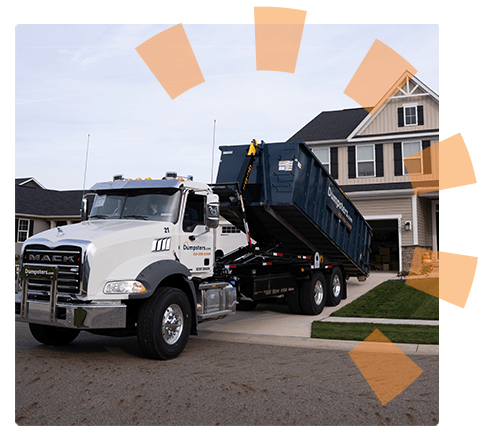
What Do Our Customers Think?
Michelle
December 15
Joe was very nice
Joe was very nice He explained everything and helped me through the process I’ve never done this before and he made it easy Ty
Vanessa Briggs
December 8
My experience with Dumpster.com was…
My experience with Dumpster.com was smooth and efficient. The dumpster arrived on time, was the right size, and pickup was hassle-free. It made managing waste for my project much easier.
Steve Biggs
December 8
Awesome experience with this dumpster…
Awesome experience with this dumpster service. I called and requested a 20 yard drop trailer for next day or same day. Within 20 minutes the driver called and was on the way. Driver verified drop spot. Very friendly , professional and happy to have my business. Fair pricing. GREAT SERVICE

Where Do We Take Your Trash?
Trash in the St. Louis area goes to a nearby disposal site.
Local Accepted Materials

Residential & Construction
We accept the following debris in our roll off dumpsters:
- construction debris
- wood & drywall
- roofing materials
- concrete
- block
- brick
- dirt
- asphalt
- gravel, stone & rock
- household junk
- carpet
- flooring
- appliances
- electronics
- furniture
- mattresses & box springs
- yard waste
- stumps
Restrictions or notes may apply.

Commercial
We accept the following debris in our front load dumpsters:
- general trash
- food waste
- paper
- cardboard
- plastic
- packaging materials
- office supplies
- electronics
- broken dishware
Other Nearby Locations We Service
Check out other nearby communities in and near St. Louis.
